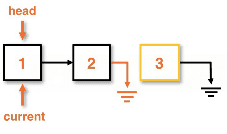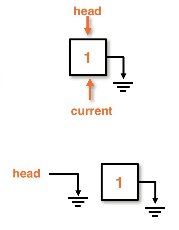singly linked lists
Singly-linked lists (SLL) are the basic building blocks of the LinkedList structural design.
ArrayLists were considered a dynamic data structure, though they require manual resizing and upkeep in the methods.
LinkedLists do not require resizing operations and can expand indefinitley..
Linkedlist
These are an alternative to arrays and overcome the some of the drawbacks of using arrays.
Linkedlist points:
- Implements the list ADT, similar to Arraylist
- does not store data contiguously in memory, data is stored in nodes
- linked data structure is a collection of nodes
- data is stored in the Node object
- connections between nodes is done by having each node point to the next node in the list
- data is not stored contiguously like in ArrayList
Head pointers
Every node in a linkedlist has a head pointer that points to another node.
- If the head is null, then the singly linked list is empty
Node class
For this example the node class is private, this is to avoid having other external classes make node objects.
The example below uses a static sub-class from the SinglyLinkedList parent.
Attributes on nodes:
- Nodes should only be made by the
SinglyLinkedList - A node will have some
dataattribute and a header,next- in this case the header is an object reference
// the parent class has access to the attributes
// of each Node
public class SinglyLinkedList {
// private sub-class
private static class Node {
private int data;
private Node next; // the reference header
// constructor
private Node(int data, Node next) {
this.data = data;
this.next = next;
}
// alternative constructor chained to the
// full constructor, adding flexibility
private Node(int data) { this(data, null); }
}
}
Adding nodes to the list (method)
After the constructor of the node is complete, helper methods can be added.
Note: When reassigning pointers we need to be careful, we can easily lose track of the rest of the list if our pointer is assigned improperly.
Adding a node to the front:
- Create the node itself
- Includes all data required
- Set the new node's next reference points to the same node as the new node
- Set the head to be the new node
Adding a node to the back:
- Verify that the list itself is not null
- If the list is null, just make a
Node
- If the list is null, just make a
- We have to iterate to the back of the list
- Once we reach the back of the list (last known node):
- Set the
current.nextequal to a newNodeobject
- Set the
public class SinglyLinkedList {
// full constructor omitted for brevity
private Node head;
public void addToFront(int data) {
Node newNode = new Node(data);
newNode.next = head;
head = newNode;
}
public void addToBack(int data) {
if (head == null) { // List is empty
head = new Node(data);
} else {
Node current = head;
while (current.next != null) {
current = current.next;
}
current.next = new Node(data);
}
}
}
Adding Nodes to a the front of a SinglyLinked list:
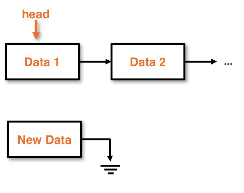
Adding Nodes improperly can cause a circular pointer reference that loses the list:
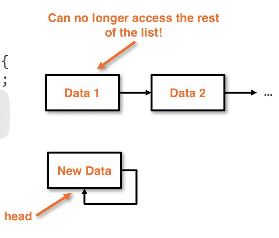
Adding Nodes to the back of a SinglyLinked list:
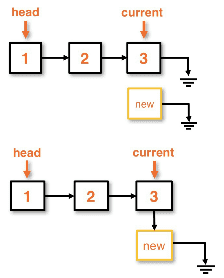
toString() (method)
There are two implementations of toString() for this to
return the data from nodes. One is a public method for the node itself
and the other is a public method for the SinglyLinkedList object.
public class SinglyLinkedList {
// private sub-class
private static class Node {
private int data;
private Node next; // the reference header
// constructor
private Node(int data, Node next) {
this.data = data;
this.next = next;
}
private Node(int data) { this(data, null); }
// just use the toString() method of the data
// in this case the data is an `int`
public String toString() { return Integer.toString(); }
}
public String toString() {
String answer = ""; // keeps track of all the string
Node current = head; // reference to the current node
// once we hit the last node, the next one will be null
while (current != null) {
answer += current = " ";
current = current.next;
}
return answer;
}
}
Remove nodes from singlylinked lists
Removing nodes from a singly linked list has different techniques, some take advantage of garbage collection
- In Java's garbage collection once we move a pointer and discard it, it will be deallocated and we cannot retrieve that data again
public class SinglyLinkedList {
// full constructor omitted for brevity
// by using garbage collection we can just
// change the first position to remove
public void removeFromFront(int data) {
head = head.next;
}
// similar to `addToBack()` we have to modify
// the list itself
public void removeFromBack(int data) {
if (head == null) { return null }
else if (head.next == null) { head = null; }
else {
Node current = head;
// here we are checking to find the
// "second to last" node
while (current.next.next != null) {
current = current.next;
}
current.next = null;
}
}
}
Removing from the front of a SLL:
- This takes advantage of garbage collection
Removing from the back of a SLL:
- We have to traverse the list with a
currentvariable- then find the
next.nextwhere the Node isnull - this then signifies the end of the list, changing the
currenthead tonull
- then find the
Removing from the back of an SLL has edge cases:
- Removing where the head is
nulljust returnsnull
- Removing where the next Node is
nullsets the current head tonull- This takes advantage of garbage collection
Optimization of the linkedlist
Size variable
When working through removal having a size variable will help to reduce overhead.
A size variable should be maintained when:
- implementing
- adding to the list
- removing from the list
The size can make edge case searches in removal a concrete variable to check, this takes us from O(n) to O(1).
Tail pointer reference
By having a tail pointer on the list we can have it reference the last node.
A tail pointer would:
- add a pointer to point to the last node in the list
- adding to the back becomes an O(1) operation
- this does not solve the problem of removing from the back
- This adds edge cases for transitioning between size 0 and size 1
- this is due to the head and tail being interrelated in these cases
- both head and tail would be pointing to the same node
This essentially has the pointers going backwards!
Adding generic types
public class SinglyLinkedList<T> {
private static class Node<T> {
private <T> data;
private Node<T> next;
private Node(T data, Node<T> next) {
this.data = data;
this.next = next;
}
private Node(T data) { this(data, null); }
}
}


